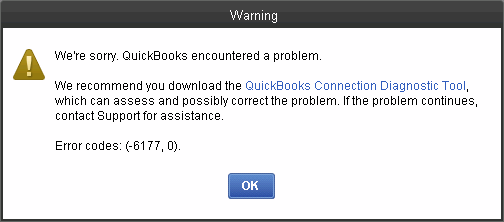QuickBooks is one of the most widely used accounting software programs, helping businesses of all sizes manage their finances with ease. However, like any software, QuickBooks can encounter errors that interrupt the workflow. One such error is QuickBooks Error 6177 0, a frustrating issue that can cause disruption when trying to open or use your company file.
In this blog, we’ll explore what QuickBooks Error 6177 0 is, why it occurs, and most importantly, how you can resolve it using simple, practical solutions.
What is QuickBooks Error 6177 0?
QuickBooks Error 6177 0 typically occurs when you try to open a company file stored in a multi-user environment or on a server that isn’t correctly configured. The error is usually accompanied by a message that reads:
“Error 6177: QuickBooks is unable to open this company file. Please ensure the file is located in a directory on your server and try again.”

This error can be frustrating because it prevents you from accessing your company file, which is critical for business operations. But don’t worry — with a little troubleshooting, you can get your QuickBooks up and running again.
Common Causes of QuickBooks Error 6177 0
Understanding the cause of the issue can help you choose the right solution. QuickBooks Error 6177 0 typically occurs for the following reasons:
- Incorrect file location: QuickBooks requires the company file to be stored in a specific location. If the file is stored on a local drive or a non-server drive, the software may encounter problems when trying to open it.
- Corrupted company file: If your company file becomes damaged or corrupted, QuickBooks may throw Error 6177 0 when you try to access it.
- Inadequate network configuration: In multi-user environments, QuickBooks must be configured correctly on both the server and client machines. If the server is not set up properly, the software may fail to open the company file.
- Antivirus or firewall interference: Security software can sometimes block QuickBooks from accessing the company file, triggering the error.
- Outdated QuickBooks version: An outdated version of QuickBooks may not be compatible with newer features or updates, leading to various errors, including Error 6177 0.
Simple Solutions for Fixing QuickBooks Error 6177 0
Now that we’ve covered the potential causes, let’s dive into the solutions to resolve QuickBooks Error 6177 0.
Solution 1: Ensure the Correct File Location
The first step is to make sure that your company file is stored in a location where QuickBooks can access it properly. QuickBooks requires the company file to be stored on the server or a network drive if you are working in a multi-user setup.
Here’s what you need to do:
- Locate the company file in Windows Explorer.
- Make sure that the file is stored on a shared folder or server, not on your local drive.
- Ensure that the folder where the file is located has full read and write permissions.
Solution 2: Update QuickBooks to the Latest Version
Outdated software versions can cause compatibility issues, leading to errors like 6177 0. If you haven’t updated QuickBooks in a while, it might be time to check for updates.
Here’s how to update QuickBooks:
- Open QuickBooks.
- Go to the Help menu.
- Select Update QuickBooks.
- Choose Check for Updates.
- Install any available updates and restart QuickBooks.
Once updated, try opening the company file again to see if the error persists.
Solution 3: Use the QuickBooks File Doctor Tool
QuickBooks offers a built-in tool called the QuickBooks File Doctor that can help diagnose and repair various issues, including Error 6177 0. Here’s how to use it:
- Download and install the QuickBooks Tool Hub from the official website.
- Open the QuickBooks Tool Hub.
- Select Company File Issues.
- Click on Run QuickBooks File Doctor.
- Follow the on-screen instructions to diagnose and repair the company file.
This tool can fix common issues like file corruption and network-related errors.
Solution 4: Check Network Configuration in Multi-User Setup
If you are using QuickBooks in a multi-user environment, ensure that the server and all client machines are set up correctly.
To resolve network configuration issues:
- Verify that all computers are connected to the same network.
- Ensure that QuickBooks is installed on both the server and all client computers.
- Make sure that the Database Server Manager is installed on the server machine.
- Ensure that the proper ports are open in your firewall and antivirus settings to allow QuickBooks to communicate over the network.
If necessary, refer to QuickBooks’ official documentation or contact support to assist with setting up your network properly.
Solution 5: Disable Antivirus/Firewall Temporarily
Sometimes, antivirus software or firewalls block QuickBooks from accessing the company file, causing Error 6177 0. You can temporarily disable your antivirus or firewall to check if they are causing the issue.
Important: Always remember to turn your antivirus or firewall back on after troubleshooting.
Solution 6: Use the QuickBooks Auto Data Recovery Tool
If you suspect that the company file is corrupted, QuickBooks offers an Auto Data Recovery (ADR) tool that may help recover your data. The ADR tool creates a backup of your file, which you can use to restore your company file.
To use ADR:
- Locate the .QBW.ADR file created by QuickBooks.
- Open QuickBooks and choose Restore a Backup.
- Select the ADR backup file and follow the on-screen instructions to restore it.
This process may take some time, depending on the size of your company file, but it can recover lost data caused by file corruption.
Additional Troubleshooting Tips
- Run QuickBooks as Administrator: Sometimes, QuickBooks may need elevated privileges to access certain files. Right-click on the QuickBooks icon and select Run as Administrator to ensure the program has the necessary permissions.
- Rebuild Your Company File: If none of the above solutions work, rebuilding your company file can often resolve persistent errors. To rebuild, go to the File menu and select Utilities > Rebuild Data.
Frequently Asked Questions (FAQ)
Q1: Why does QuickBooks Error 6177 0 occur?
QuickBooks Error 6177 0 typically occurs when QuickBooks cannot access the company file, usually due to incorrect file location, file corruption, network configuration issues, or antivirus/firewall interference.
Q2: Can QuickBooks Error 6177 0 be fixed without a backup?
Yes, you can attempt to fix the issue without a backup by using troubleshooting tools like the QuickBooks File Doctor, ensuring correct file location, and checking network configurations. If the file is corrupted, a backup may be necessary for full recovery.
Q3: Will updating QuickBooks help fix Error 6177 0?
Yes, updating QuickBooks to the latest version can resolve compatibility issues and fix bugs that might be causing Error 6177 0.
Q4: How do I know if my QuickBooks company file is corrupted?
If you are receiving error messages when trying to open your company file or if the file cannot be opened at all, it might be corrupted. Using the QuickBooks File Doctor tool or the Auto Data Recovery tool can help diagnose and resolve file corruption.
Q5: Can I prevent QuickBooks Error 6177 0 in the future?
To prevent QuickBooks Error 6177 0 in the future, ensure your company file is always stored in the correct location on a shared or network drive, keep QuickBooks updated, and maintain proper network configurations. Regular backups are also recommended to safeguard against data corruption.
Error can seem like a complex issue, but with the right approach and troubleshooting steps, it’s a problem that can be easily fixed. Whether it’s correcting the file location, updating your software, using QuickBooks’ repair tools, or checking your network setup, these solutions will help you get back on track quickly. By following these simple solutions, you can avoid disruptions to your business’s workflow and ensure your QuickBooks software runs smoothly. If the error persists or you need more advanced help, consider reaching out to QuickBooks support for further assistance.




